Amyris texana
| Amyris texana | |
|---|---|
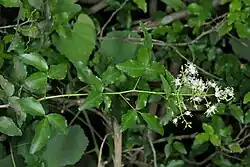
| |
| Scientific classification | |
| Kingdom: | Plantae |
| Clade: | Tracheophytes |
| Clade: | Angiosperms |
| Clade: | Eudicots |
| Clade: | Rosids |
| Order: | Sapindales |
| Family: | Rutaceae |
| Genus: | Amyris |
| Species: | A. texana
|
| Binomial name | |
| Amyris texana | |
| Synonyms | |
|
Amyris parvifolia A. Gray, 1888 | |
Amyris texana, commonly known as the Texas torchwood or chapotillo, is a species of flowering plant in the rue family, Rutaceae.[2][3] It is native to southern Texas and northeastern Mexico.[4]
Taxonomy
Texas torchwood was first described by Samuel Botsford Buckley in 1883 based on a specimen he collected in April 1882 near Corpus Christi, Texas. It was initially described as Zanthoxylum texanum, but Buckley later moved it to genus Amyris.[5][6]
Description
It is a perennial shrub, growing to a height of 4 to 6 ft (1.2 to 1.8 m) and roughly the same width.[7] The evergreen leaves are compound, with three pairs of dark green, shiny leaflets. Leaves and other parts of the plant have an earthy, citrus smell, particularly when broken or crushed. Small, cream-colored flowers grow on racemes and bloom from March until October or November.[8] Dark purple fruits form when the flowers have been pollinated, each containing one seed. The bark is mottled and lacks thorns.[9] It is able to tolerate drought and short-term exposure to freezing temperatures.[7]
Distribution and Habitat
It is found in the Tamaulipan mezquital ecoregion.[2][10] In Mexico, it is abundant in Coahuila, Nuevo León, San Luis Potosí, and Tamaulipas. It occurs in the United States only in south Texas. It is found in subtropical or tropical coastal thickets, chaparral, brush, and mesic forest understory at altitudes ranging from sea level to about 5,900 ft (1,800 m).[11]
Ecology
Texas torchwood attracts hummingbirds, butterflies, moths, bees, and other pollinators.[8] The fruits are eaten by birds, lizards, and other wildlife. Giant swallowtail butterflies (Papilio rumiko) lay their eggs on the young leaves of Texas torchwood and other Rutaceae species.[12]
Gallery
-
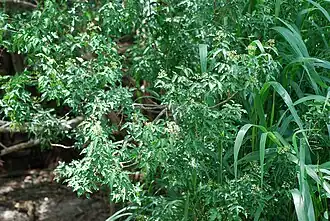 Texas torchwood (Amyris texana) observed in Hidalgo County, Texas. Photo by Douglas Goldman.
Texas torchwood (Amyris texana) observed in Hidalgo County, Texas. Photo by Douglas Goldman. -
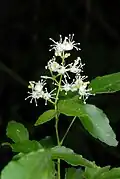 Texas torchwood (Amyris texana) observed in Hidalgo County, Texas. Photo by Douglas Goldman.
Texas torchwood (Amyris texana) observed in Hidalgo County, Texas. Photo by Douglas Goldman. -
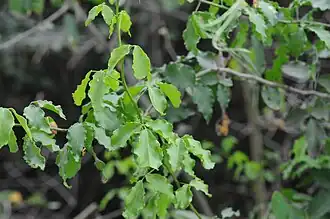 Texas torchwood (Amyris texana), Bentsen-Rio Grande Valley State Park, Mission, Hidalgo County, March 2023.
Texas torchwood (Amyris texana), Bentsen-Rio Grande Valley State Park, Mission, Hidalgo County, March 2023. -
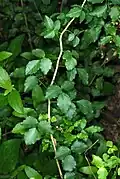 Texas torchwood (Amyris texana) observed in Hidalgo County, Texas. Photo by Douglas Goldman.
Texas torchwood (Amyris texana) observed in Hidalgo County, Texas. Photo by Douglas Goldman.
References
- ^ "NatureServe Explorer 2.0". explorer.natureserve.org. Retrieved 14 August 2025.
- ^ a b "Amyris texana (Buckley) P. Wilson". Plant Database. Lady Bird Johnson Wildflower Center. 14 November 2022. Retrieved 14 March 2025.
- ^ "Texas Torchwood". nativeplantproject.com. Native Plant Project. 15 May 2012. Retrieved 14 March 2025.
- ^ "Amyris texana (Buckley) P.Wilson". Plants of the World Online. Royal Botanic Gardens, Kew. Retrieved 14 March 2025.
- ^ Bulletin of the Torrey Botanical Club. Missouri Botanical Garden. New York: Torrey Botanical Club. 1870.
{{cite book}}: CS1 maint: others (link) - ^ Bonisteel, William J.; Bonisteel, William J.; Broadhurst, Jean; Clum, Harold Haydn; Hastings, George T.; Howe, Marshall A.; Taylor, Norman (1908). Torreya. Vol. v.8 1908. Burlington, Vt: Torrey Botanical Club.
- ^ a b "Texas Torchwood". Garden Style San Antonio. Retrieved 14 April 2025.
- ^ a b "Plant database entry for Chapotillo (Amyris texana) with one image and 49 data details". garden.org. Retrieved 14 April 2025.
- ^ Star, Special to the (11 April 2021). "Texas Torchwood - Chapotillo". MyRGV.com. Retrieved 14 April 2025.
- ^ Shindle, David B.; Tewes, Michael E. (1998). "Woody Species Composition of Habitats used by Ocelots (Leopardus pardalis) in the Tamaulipan Biotic Province". The Southwestern Naturalist. 43 (2): 273–279. JSTOR 30055366.
- ^ Esteban Martínez Salas; Alejandra Fuentes (National Autonomous University of Mexico); Samain, Marie-Stéphanie (17 November 2020). "IUCN Red List of Threatened Species: Amyris texana". IUCN Red List of Threatened Species. Archived from the original on 6 May 2025.
- ^ Shiraiwa, Kojiro; Cong, Qian; Grishin, Nick V. (23 December 2014). "A new Heraclides swallowtail (Lepidoptera, Papilionidae) from North America is recognized by the pattern on its neck". ZooKeys (468): 85–135. doi:10.3897/zookeys.468.8565. ISSN 1313-2970. PMC 4296521. PMID 25610342.

